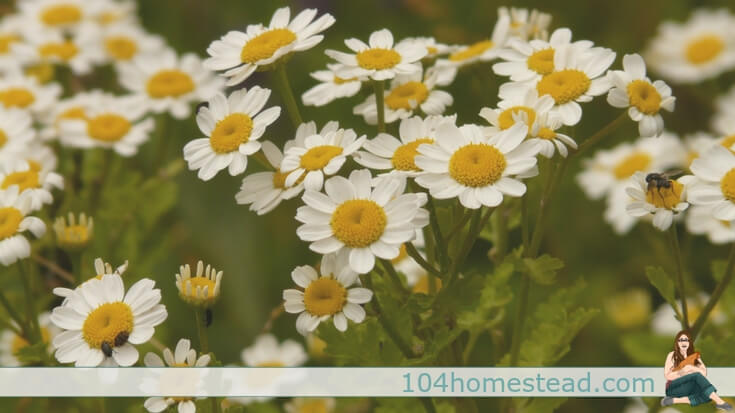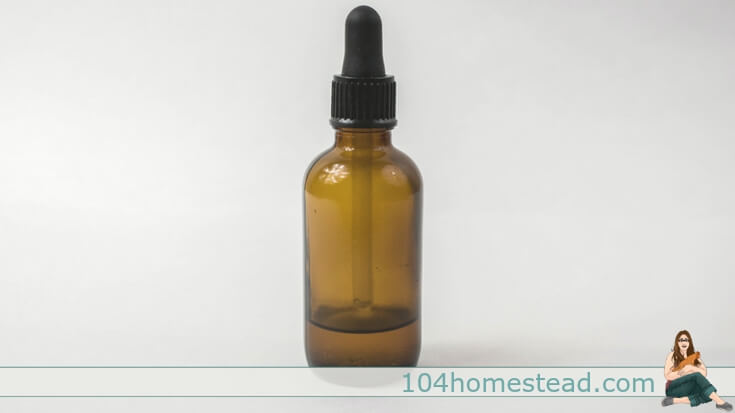Feverfew for Migraines: A Multipurpose Medicinal Herb
Are you ready to try feverfew for migraines instead of grabbing for an Excedrin? This tincture is an easy way to get started.

Feverfew (Tanacetum parthenium) is a member of the daisy family and it makes a wonderful addition to your herbal garden. Not only is is a beautiful plant with tiny white petals and a great big yellow center, it’s great for migraine sufferers. Migraine and headache relief is it’s most common medicinal use, but if offers so much more.
Medicinal Uses
Feverfew has been used for ages to relieve headaches, treat stiffness from arthritis, and help with labor and childbirth. Although the name suggests it would work well for fevers, studies have shown it’s not very effective at doing so. Extensive research on the medicinal uses of feverfew were limited until recently, but as more and more people turn to herbalism to treat common ailments, more studies have been done on it’s effects on the body. It’s thought to hinder the production of prostaglandins, the hormone-like substances that cause pain and inflammation. This is why it’s considered effective for treating various types of arthritis.
Feverfew for Migraines
The most notable field of research regarding feverfew, however, is in the areas of head pain — migraines, tension headaches, and stress-induced headaches.
A review completed by the School of Postgraduate Medicine & Health Science in the U.K. compared the results of six studies of feverfew for migraines. Researchers found that feverfew is effective in the prevention of migraine headaches and doesn’t pose any major safely concerns. – Public Health Nutr. 2000 Dec;3(4A):509-14
Despite the fact that it states there are no major safety concerns, I urge you to still practice herbalism safely. Always consult a doctor before providing herbs to children. Also consult a doctor if you are pregnant or on blood thinners.
Growing Feverfew in Your Garden
Feverfew can easily be grown from seed. The seeds are easy to find at most garden centers and online retailers. Before you go out to purchase seeds, though, you may want to ask some friends. Feverfew can be prolific and you may have friends who are ready to thin their out. Transplant or direct sow in a sunny location. Soil type isn’t much of an issue since this is a hardy and adaptive plant. It’s even suitable in containers.

You’ll start to see flowers that very first year, blooming from July to October in most parts of the country. It’s a self-seeding perennial, so cut back to the ground in the fall.
Cutting the blossoms from your plants will keep them in bloom for longer. If you’re harvesting for medicinal purposes, harvest the full stems that have open blooms and healthy green leaves. Feverfew for migraines calls for a combination of flowers and leaves.
Feverfew Migraine Tincture Recipe
Are you ready to try feverfew for migraines instead of grabbing for Excedrin? A tincture is an easy way to get started. This is the recipe I’ve been using for the last few years and I’ve been really happy with it.

Supplies
- A quart mason jar with lid
- Cheesecloth
Ingredients
- 1/2 cup Lemon Balm (a little over 2 oz)
- 1/3 cup Feverfew (a little under 2 oz)
- Approximately 3 1/2 cups 100 Proof Vodka
Recipe
Collect lemon balm leaves and a combination of feverfew leaves and blossoms. Wash them thoroughly and chop until they are fine.
Add your chopped herbs to your jar and fill the jar with vodka. Your herbs should be 1-2″ below the surface. This is a good time to label your jar with the contents as well as the date. You’ll think you can remember what’s in it and when it was prepared, but life happens.
Place your jar on a warm, sunny windowsill. You’ll want to leave it there for four or five weeks, shaking daily. After that time, strain the mixture with a cheesecloth into an amber bottle. You can use clear glass if you prefer, but the amber bottles really do keep your tinctures potent for a longer period of time.
This tincture is good at room temperature for up to 5 years if kept in a cool, dark place.
If you’ve found value in this blog post and enjoyed reading it, why not share it with your Pinterest community? Pin the image below and spread the love!


Just a couple questions to help clarify things for me. When you are using fresh herbs, isn’t there a risk of mold in a tincture during the time it is closed up in the bottle? Also I didn’t see a dosage amount. I’m just learning to do this. Thank you for all your help
Please what is the recommended dose for migraines? Everything in the article was on point – the end to indicate how to administer dosage was left off.
Thx for your attention…
Hi there
Thank you so much for this article.
I have lots of feverfew growing in my garden and my mother visited and told me it is an amazing healing plant which led me to you. I don’t have any fresh lemon balm leaves – can I substitute with dried ones I can buy using this recipe? I have already ordered the 100 vodka and really keen to make this thank you
Can you tell how many drops to take and how often? At onset? throughout?
I read a lot of blog posts!! This is great content work.
So what do you do with it once it’s sat for several weeks? There’s no further instructions.
Good article, I know the effect of flowers and new plants.
How much should be taken and how often?
Yes. How do use it for migraines and for arthritis? Also, should plants be fresh or dry?
Tinctures are the easiest way to take it. The lemon balm and feverfew can be fresh or dried. I prefer fresh myself.
I have the double bloom variety does it work the same
I’m not familiar enough with those to say for sure. Do you know the latin name?
Great article except…How do you use it?
I have tons of it this year because last year I got busy with life and my feverfew went to seed and now covers a third of my gadrden area!
How do you use it please?